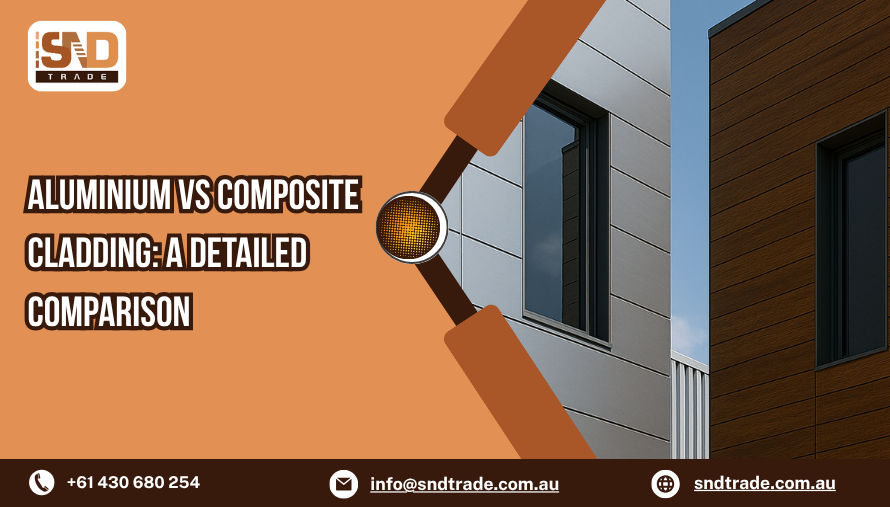When choosing cladding for your home or commercial project, two popular options often come up — aluminium and composite cladding. Both materials are modern, durable, and widely used across Australia. But which one is right for your space? If you’re exploring composite cladding in Melbourne or sourcing materials from trusted cladding suppliers in Australia, this guide will help you compare the two in simple terms.
What is Aluminium Cladding?
Aluminium cladding is made from lightweight metal panels that are either solid or part of an aluminium composite material. It’s widely used for both residential and commercial buildings, especially where a sleek, modern look is desired. You’ll often see it on apartment blocks, office buildings, and urban homes because it’s durable and clean-looking.
What is Composite Cladding?
Composite cladding, commonly made from wood-plastic composite (WPC), is a mix of recycled wood fibres and plastics. It’s designed to give the natural look of timber without the hassles of rot, termites, or high maintenance. Composite cladding is becoming more and more popular for Australian homes, outdoor areas, and low-rise commercial spaces.
Look and Feel: Natural vs Modern
If you’re going for a clean and professional look, aluminium cladding is the winner. It’s great for sharp lines and modern design and comes in a wide range of colours and finishes like matte, metallic, and powder-coated.
On the other hand, composite cladding gives a warm and natural timber effect. It’s perfect for those who want a more earthy, relaxed look without the hassle of real wood. It also blends beautifully with outdoor spaces and landscaping features.
✔ Style Tip: Go with aluminium for ultra-modern designs. Choose composite if you want a timber look with zero maintenance.
Durability in Australian Conditions
Aluminium is built tough. It doesn’t warp, rot, or rust and is perfect for all Aussie climates — from the coast to the outback. It’s also fire-resistant and can last decades with little effort.
Composite cladding is also highly durable and handles moisture, UV rays, and heat well. While it’s not as strong as aluminium in high-impact areas, it’s perfect for everyday residential and light commercial use.
✔ Verdict: Aluminium edges out for extreme durability, but composite is more than strong enough for most homes and buildings.
Maintenance: Easy Living with Both
Both aluminium and composite cladding are low-maintenance, which is great news for busy homeowners and tradies. Aluminium just needs a wipe-down every now and then to keep it clean. It doesn’t need painting or sealing.
Composite cladding is also fuss-free. It won’t need staining, oiling, or repainting. A quick wash with water and soap is all it takes to maintain that “just installed” look.
✔ Tie: Both materials are excellent for low-maintenance living.
Environmental Impact
Sustainability is a big deal in 2025, and both materials have eco-friendly benefits. Aluminium is 100% recyclable and many products now use recycled aluminium. However, manufacturing aluminium can be energy-intensive.
Composite cladding shines in this category. It’s often made from recycled wood and plastic, making it a great choice for reducing landfill waste. Its long lifespan also means fewer replacements over time.
✔ Green Choice: Composite cladding is generally more eco-friendly.
Fire Safety Compliance
Fire safety is critical in Australian construction. Aluminium cladding — especially solid panels — is non-combustible and widely used in buildings where fire compliance is mandatory. Always make sure you’re getting certified materials from trusted cladding suppliers in Australia.
Composite cladding isn’t naturally fireproof, but many options are treated to meet Australian fire safety standards. However, it may not be suitable for high-rise or high-risk areas unless specifically rated.
✔ Safety First: Aluminium is the safer option for fire-sensitive projects.
Cost and Installation
Aluminium tends to cost more upfront and usually requires professional installation due to its rigid panels and custom designs. However, it’s a long-term investment, especially for large buildings.
Composite cladding is more affordable, easier to install, and great for both tradies and DIYers. Many systems use interlocking panels, which save time and reduce labour costs.
✔ Budget Pick: Composite wins for affordability and ease of installation.
Where They Work Best
Aluminium cladding is ideal for:
- Commercial buildings
- High-rise apartments
- Coastal or exposed areas
- Modern and minimalistic designs
Composite cladding is perfect for:
- Residential homes
- Outdoor living areas
- Feature walls
- Eco-conscious projects
✔ Pro Tip: For fire-rated, high-end applications, aluminium is the go-to. For beautiful and cost-effective home projects, composite is a winner.
Choosing the Right Supplier Matters
Whatever material you choose, working with experienced cladding suppliers in Australia is essential. At SND Trade, we supply both composite cladding in Melbourne and aluminium options tailored to Australian building standards.
Our team can help you compare materials, provide samples, and ensure you’re getting cladding that’s compliant, long-lasting, and perfect for your project. We deliver across Australia and work closely with builders, designers, and homeowners to bring their vision to life.
Final Thoughts
Choosing between aluminium and composite cladding depends on your goals. Aluminium is stronger and better for fire safety, while composite offers affordability, easy installation, and a beautiful natural look. Both are excellent choices — it just comes down to your project needs and personal style.
Still unsure? Reach out to the friendly team at SND Trade. We’ll help you explore the best cladding options, show you real-life applications, and make sure your next build looks brilliant — and lasts for years.

